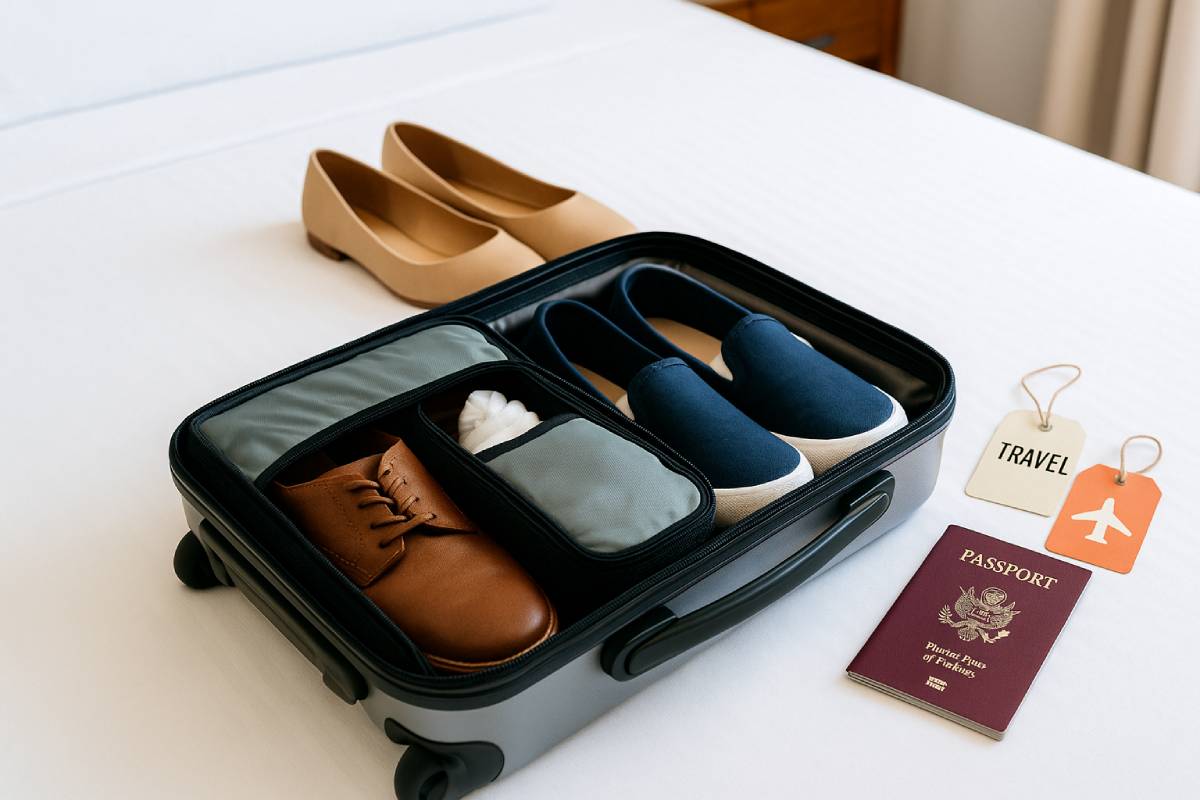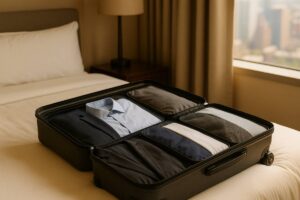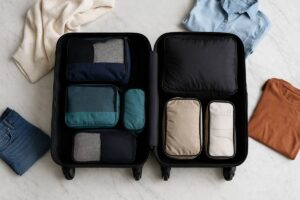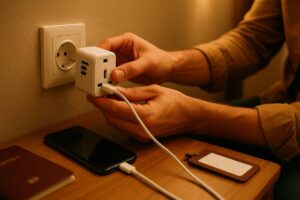Shoe bulk turning your packing into a puzzle? You’re not alone. Compression packing cubes can shrink luggage volume by up to 30% when you zip them down, thanks to clever design and sturdy zippers.
Stuffing shoes with socks or rolled underwear taps into hidden hollow space and preserves shape, a hack Southern Living editors swear by.
Machine-washable shoe bags isolate dirt and odors—Travel + Leisure’s top picks hold up through 100+ wash cycles.
Arranging shoes heel-to-toe at the suitcase base stabilizes weight and protects garments above, per Travelpro pros.
And pros live by the “Rule of Three”: pack no more than three pairs, including your worn-on-board shoes, to stay light and nimble.
Preparing Your Shoes

Efficient shoe packing starts with thorough preparation: cleaning off all dirt and ensuring complete dryness to prevent unwanted odors or mildew. Choosing neutral, lightweight styles that mix and match across multiple outfits keeps bulk—and decision fatigue—down.
Finally, most travel pros agree on the “three-pair rule,” packing no more than three pairs (including the ones you wear), which strikes the perfect balance between variety and space savings. By combining these strategies, you’ll free up room for everything else in your suitcase without sacrificing style or comfort.
Clean and Dry
Before you do anything else, give your shoes a thorough clean to remove dirt, dust, and grime that can transfer to your clothes. Always ensure your shoes are completely dry before packing to prevent moisture-related odors or mildew growth. Travelpro advises using travel-size shoe cleaners or a soft brush with a slightly damp cloth for best results. Stuff the interior of each shoe with dry socks or newspaper to absorb any remaining dampness and help maintain shape.
Select Versatile Pairs
When choosing which shoes to bring, prioritize neutral colors and lightweight materials that transition seamlessly from casual explorations to evening events. According to Lonely Planet, mix-and-match styles like low-profile sneakers, simple loafers, or multifunctional sandals maximize outfit options while minimizing bulk.
Aim for footwear with breathable, quick-drying fabrics to keep your feet comfortable in varying climates. Pro tip: pick one pair of walking shoes, one pair of day-to-night flats or loafers, and one versatile sandal to cover most activities.
| Shoe Type | Versatility | Approx. Weight | Best For |
|---|---|---|---|
| Low-profile sneakers | High (casual + active) | Medium-light | City tours, light hikes |
| Loafers / flats | Medium (casual + semi-formal) | Light | Day-to-night dinners, meetings |
| Multifunctional sandals | Medium (casual + warm weather) | Very light | Beach days, strolls, relaxed dining |
Table data based on mix-and-match recommendations from Lonely Planet.
Quantity Rule
Overpacking shoes can weigh you down, so the consensus among packing experts is to limit your collection to three pairs or fewer—including the pair you plan to wear on travel days. Allianz recommends two to three pairs for extended trips, noting that two should cover most situations while a third can handle unexpected weather or dressier events.
Rick Steves travelers echo this rule, typically packing one sneaker, one hybrid casual shoe, and one dressier option for flexibility. InStyle’s travel guru adds, “Sticking to three pairs keeps your luggage light and your choices smart,” making every ounce count.
Materials and Tools Needed
Efficient shoe packing starts with choosing the right materials and tools to protect your footwear, compress bulk, and keep everything organized. Compression packing cubes and dedicated shoe bags can shrink your shoe volume by up to 30%, giving you room for more essentials without risking scuffs or dirt—expertly tested by Travel + Leisure’s team of packers.
For zero-cost protection, simple shower caps or grocery bags act as effective barriers against grime and scratches, a hack long endorsed by Condé Nast Traveler. And never underestimate the power of stuffing: filling each shoe with socks or other small items not only preserves shape but also doubles as extra packing space, a tip travel guru Samantha Brown swears by.
Shoe Bags & Packing Cubes
Protective layers that also compress bulk. Invest in high-quality nylon shoe bags or compression packing cubes to shield shoes and save space:
- Compression Packing Cubes: Travel + Leisure tested 29 different cube sets over five months and found they save about 30% of packing space when fully compressed.
- Separate Shoe Bags: Many cube sets include a dedicated shoe bag made from waterproof nylon, keeping shoes isolated and clothes dry—even if leaks occur.
- External Straps: The best travel shoe bags feature external compression straps to squeeze out excess air and minimize bulk.
| Product | Capacity | Compression Feature | Material | Dimensions |
|---|---|---|---|---|
| Veken Packing Cube Set | 6 cubes (incl. laundry & toiletry bags) | Exterior compression zippers save up to 50% space | Nylon & mesh | Largest cube: 16.5×8.3×5.5 in |
| Nathomaim Compression Cubes | 10-piece set | Brand claims up to 60% space savings | Polyester | Multiple sizes (set) |
| External Compression Shoe Bag | Fits up to 2 pairs | External straps to squeeze out air | Nylon | 16.5×8.3×5.5 in |
Shower Caps or Grocery Bags
Budget-friendly barriers to guard against dirt. Before packing, cover the soles and sides of each shoe with:
- Shower Caps: A classic hack from Condé Nast Traveler: simply slip a disposable shower cap over each shoe to lock in dirt and prevent scuffs.
- Grocery Bags: In a pinch, sturdy plastic grocery bags work just as well—tie or tuck them securely around shoes for zero-cost protection.
Socks & Small Items
Dual-purpose stuffing materials. Fill the cavity of each shoe with:
- Socks & Underwear: These soft items absorb moisture, help shoes retain their shape, and free up space elsewhere in your bag.
- Other Small Gear: Think belts, electronics cables, or small toiletries—anything that fits helps maximize every cubic inch.
Pro Tip: Pack heavier shoes first at the bottom, then place cubes or stuffed shoes around them to lock everything in place and maintain suitcase balance.
Space-Saving Techniques
Maximizing luggage space while protecting your shoes is all about clever use of hollow areas, protective barriers, and smart organization. Stuffing shoes with socks, underwear, or rolled clothing can utilize internal volume and help maintain shape.
Wrapping each pair in shower caps, grocery bags, or reusable cloth bags keeps soil and scuffs at bay without adding bulk.
Placing shoes heel-to-toe along the bottom of your suitcase creates a stable base and minimizes wasted space. Finally, packing cubes and compression or vacuum bags can shrink shoe volume by up to 80%, leaving extra room for clothes and essentials.
A. Stuffing Inside Shoes
Fill each shoe with socks, underwear, or rolled-up clothing to use all available hollow space, keep shoes upright, and prevent deformation during transit. For boots, this approach not only saves room but also locks in shape, allowing you to pack garments around them without squashing the leather or fabric.
B. Protective Wrapping
Cover shoes with disposable shower caps, sturdy grocery bags, or washable cloth shoe bags to guard against dirt and scuff marks. A simple shower cap over the sole and sides can prevent grime from transferring to your clothes, a hack endorsed by Condé Nast Traveler and echoed by minimalist packers worldwide. Reusable cloth bags add an eco-friendly spin while keeping shoes isolated from linens and garments.
C. Strategic Placement
Arrange shoes heel-to-toe along the bottom perimeter of your suitcase, with soles facing outwards, to form a compact, interlocking row that stabilizes the bag’s contents. If your luggage has side pockets or a dedicated shoe compartment, slide each wrapped pair into these spaces first to free up central volume for bulkier items.
Tip: Alternate left and right shoes to nestle heels into toes for a tighter fit and minimal shifting.
D. Using Packing Cubes & Compression Bags
Leverage packing cubes and compression or vacuum bags to group and condense your shoes even further:
| Tool | Space Savings | Notes |
|---|---|---|
| Standard Packing Cube | Moderate; keeps items contained | Organizes up to 2 pairs per cube |
| Compression Packing Cube | High; additional zipper reduces bulk | Tested by Travel + Leisure as a top space-saver |
| Vacuum/Compression Storage Bag | Up to 80% less volume | No vacuum needed; dual-zipper design |
- Packing Cubes: These structured, zippered bags hold shoes snugly and keep them from rolling around, cutting down on loose bulk.
- Compression/Vacuum Bags: Ideal for bulky boots or when shoe bags alone aren’t enough—press out air to slash volume by up to 80% without special pumps.
By combining these four techniques—stuffing, wrapping, strategic placement, and compression—you’ll pack shoes efficiently, protect your wardrobe, and leave room for souvenirs on every trip.
Weight Distribution & Balance
Proper weight distribution is the unsung hero of efficient packing. Placing heavier shoes at the bottom of your suitcase lowers its center of gravity, dramatically reducing the risk of tipping over when you stand it upright. Travelpro experts agree that tucking shoes in the main compartment near the wheels not only stabilizes your bag but also protects delicate garments above them.
SmarterTravel pros add that distributing weight evenly between both sides prevents the suitcase from pulling to one side and straining zippers or wheels. According to Kosh-a’s packing guide, alternating layers of heavy and light items creates a balanced load that’s easier to maneuver and less prone to shifting in transit.
And Calpak notes that using your suitcase’s side pockets for smaller shoes or heavy accessories further evens out weight distribution, making every step through the airport smoother.
Place Heavier Shoes First at the Base to Stabilize the Load
Start by lining the bottom of your suitcase (on the side with the wheels) with your bulkiest footwear. This approach:
- Lowers the Center of Gravity: Shoes at the base keep your bag standing upright, minimizing tip-overs.
- Protects Clothes: Heavier shoes absorb jostling impacts, shielding lighter garments above.
- Optimizes Space: Real Simple pros confirm that heavier items at the bottom help compress softer layers above, squeezing out extra inches of room.
Balance Weight Evenly to Avoid Tipping and Uneven Wear
Once shoes are in place, focus on side-to-side balance:
- Even Load Across Wheels: Distribute remaining shoes or gear equally between both suitcase compartments to prevent lopsided pulling.
- Layer Strategically: Alternate heavy items (boots, sneakers) with lighter ones (sandals, flats) to maintain an even weight profile.
- Utilize Side Pockets: Stash small, dense items—like flats or travel adapters—in side pockets to fine-tune your bag’s equilibrium.
| Placement Strategy | Stability Impact |
|---|---|
| Shoes at base, near wheels | Highly stable; minimizes tipping |
| Even weight on both sides | Balanced load; prevents pull to one side |
By mastering these weight-distribution techniques, you’ll protect your shoes, preserve your suitcase’s integrity, and breeze through every travel checkpoint with confidence.
Eco-Friendly & Budget Options

Embracing eco-friendly and budget-wise shoe-packing options not only cuts waste but also keeps costs down and your gear organized. Machine-washable shoe bags, praised by Travel + Leisure, can be tossed in the laundry hundreds of times—saving roughly $80 in single-use liners over five years.
These nylon or mesh bags breathe well, prevent odors, and maintain sustainability on the road. On the ultra-budget end, repurposed plastic grocery bags serve as instant, zero-cost barriers—Southern Living notes they last through 5–10 trips before wearing out. Bon Appétit ranks grocery bags among the top five unconventional but effective packing hacks, especially when you recycle them properly afterward.
For sturdier disposal options, Reddit travelers recommend freezer or bedding plastic bags that handle dirt and moisture for 10+ uses. And if you want to go a step further, AFAR highlights cloth shoe bags made from recycled plastic bottles, combining durability with landfill-diverting impact.
Use Machine-Washable Travel Shoe Bags
- Durability & Reuse: Mesh or nylon shoe bags rated machine-washable by Travel + Leisure handle 100+ cycles without degradation.
- Odor Control: Ventilated fabrics let shoes air out between trips, preventing mustiness.
- Cost Savings: At $12 average retail price, you break even after ~40 trips versus buying disposable liners.
Repurpose Plastic Grocery Bags
- Zero-Cost Barrier: Free and everywhere, grocery bags shield clothes from dirt—Southern Living reports 5–10 reuses before tearing.
- Waste Reduction: Bon Appétit ranks this as a top five packing hack, emphasizing proper recycling once the bag wears out.
- Durable Alternatives: Heavy-duty freezer or bedding bags can safely contain muddy shoes for 10+ trips.
Comparison Table
| Option | Cost per Bag | Reusability | Eco Impact |
|---|---|---|---|
| Machine-Washable Nylon/Mesh Shoe Bag | $10–$20 | 100+ uses | High – durable, reduces single-use waste |
| Recycled-Bottle Cloth Shoe Bag | $20–$30 | 50+ uses | Very High – made from post-consumer plastics |
| Plastic Grocery Bag | $0 | 5–10 uses | Medium – repurposes existing plastic |
| Freezer/Bedding Plastic Bag | $0 | 10+ uses | Medium – heavy-duty repurposed plastic |
By choosing reusable shoe bags or smartly repurposing household plastics, you’ll travel lighter, cleaner, and greener—without breaking the bank.
Alternative Shoe Containers
When suitcase space is tight, thinking outside the packing cube can make all the difference. Original shoe boxes snugly cradle each pair in its custom-fit container, keeping delicate styles protected and neatly stackable at the bottom of your bag.
If you’re hopping between hostels or carrying on a backpack, a lightweight hanging shoe organizer unrolls to reveal dozens of pockets—then tucks flat and disappears until you need it. Both approaches guard against scuffs, simplify airport security checks, and free up central luggage space for clothes and souvenirs.
Original Shoe Boxes
Original shoeboxes offer the ultimate custom fit—each pair nests in its branded container, preserving shape and style without wasted volume. Line each box with crumpled packing paper or bubble wrap to cushion fragile heels and fill empty corners for extra stability.
Stack these boxes at the base of your suitcase—ideally on the wheel-side—to create a sturdy foundation and keep shoes from shifting. If you’ve purged old boxes, invest in travel-specific shoe boxes (rigid plastic or foldable designs) to gain the same benefits without the bulk of cardboard.
Hanging Shoe Organizers
A hanging shoe organizer unfolds into a wall-mounted display with 10–24 mesh pockets, perfect for stashing shoes in carry-on backpacks or hostel rooms.When packed, it rolls or folds flat—sliding easily into a side pocket—then hooks over a door or closet rail for instant access to your footwear collection.
Reddit travelers praise collapsible over-the-door organizers for keeping shoes and small accessories separated on the road, cutting down on digging through bags. A viral YouTube Shorts hack even shows using these organizers inside hostel lockers to secure shoes off the dusty floor.
Comparison Table
| Container | Space Efficiency | Capacity | Best Use |
|---|---|---|---|
| Original Shoeboxes | Low–Moderate | 1 pair per box | Designer or formal shoes; base layer |
| Hanging Shoe Organizer | High | 10–24 pockets | Carry-on backpacks; hostel stays |
By choosing the right alternative container—whether stackable boxes or a versatile hanging organizer—you’ll protect your shoes, streamline packing, and maximize every inch of luggage real estate.
Tips for Specific Shoe Types
Efficiently packing boots involves stuffing them with socks or leggings, then standing them upright inside compression packing cubes to preserve shape and create a stable base in your luggage. For heels and formal shoes, folding in layers of tissue paper and wrapping with soft cloth or shoe bags cushions pointed edges and prevents scuffs during transit.
Athletic shoes should be thoroughly cleaned—insoles scrubbed with a mild soap or vinegar solution—and air dried completely, while tea bags or baking soda can absorb lingering moisture and odor before packing.
Boots
- Stand Upright in Packing Cubes: According to Travel + Leisure, stuffing your boots with socks or leggings, then packing them upright inside a compression cube maintains their natural shape and prevents creasing.
- Allow Airflow: Mighty Travels recommends mesh-backed packing cubes for cowboy or leather boots, which support upright storage while reducing moisture buildup.
- Avoid Overcompression: Ensure boots are snug but not flattened—overcompressing can distort leather or suede shafts.
Heels / Formal Shoes
- Layer with Tissue Paper: On the Women Who Travel podcast, experts advise folding a layer of tissue around heels before placing them in a pouch to cushion pointed edges and prevent scuffs.
- Use Soft Fabric Wraps: Condé Nast Traveler suggests packing heels in cloth shoe bags or microfiber pouches to keep them scratch-free and separate from other items.
- Insert Extra Padding: For added protection, tuck small pieces of soft fabric or an unused T-shirt inside the toe box to maintain shape and absorb moisture.
Athletic Shoes
- Deep Clean & Air Dry: Before packing, remove insoles and scrub them with mild soap or a vinegar-and-water mix; rinse thoroughly and let both shoes and insoles air dry completely to prevent odor-causing bacteria.
- Refresh with Baking Soda: Wipe the exterior with a damp cloth and a paste of baking soda to lift grime, then leave shoes upright in a well-ventilated spot until fully dry.
- Odor Control Hacks: Reddit travelers recommend stuffing shoes with dry tea bags or paper packets overnight to absorb lingering moisture and odors, then wrapping them in a towel before slipping into a grocery bag for transport.
By tailoring your approach to each shoe type—upright compression for boots, padded wraps for heels, and thorough cleaning for athletic shoes—you’ll maximize space, protect your footwear, and travel in style.
Conclusion
Efficient shoe packing is part science, part art—and entirely worth mastering. By starting with a squeaky-clean, fully dry pair of shoes, you prevent odors and mold before they start. Next, strategic stuffing and protective wrapping transform each shoe into a space-saving vessel that also safeguards your wardrobe.
Heel-to-toe placement at the suitcase base creates a stable foundation, while compression cubes take you the rest of the way—reducing packed shoe volume by nearly one-third. Keep weight balanced with heavier pairs at the bottom, and never exceed three pairs total to stay nimble on the road.
Finally, embrace sustainability with reusable mesh bags or budget-friendly plastic liners. Follow these steps on your next trip, and you’ll travel lighter, cleaner, and more organized—ready for whatever adventure awaits.
FAQs
How many pairs of shoes should I pack?
Stick to three pairs max—including the one you wear—so you have variety without the bulk.
Can I use compression bags for boots?
Yes—vacuum or compression bags can cut boot volume by up to 60%, but don’t overcompress to the point of deforming leather.
Will stuffing shoes with clothes damage them?
No—soft items protect shape and absorb moisture. Just avoid overstuffing stiff materials into delicate footwear.
Which shoe bag material is best?
Mesh or nylon shoe bags with ventilation prevent odor and are machine-washable for 100+ cycles.
How do I prevent shoe odor in packed shoes?
Clean and fully air-dry shoes; then insert odor absorbers like baking soda packets or dry tea bags before packing.





















